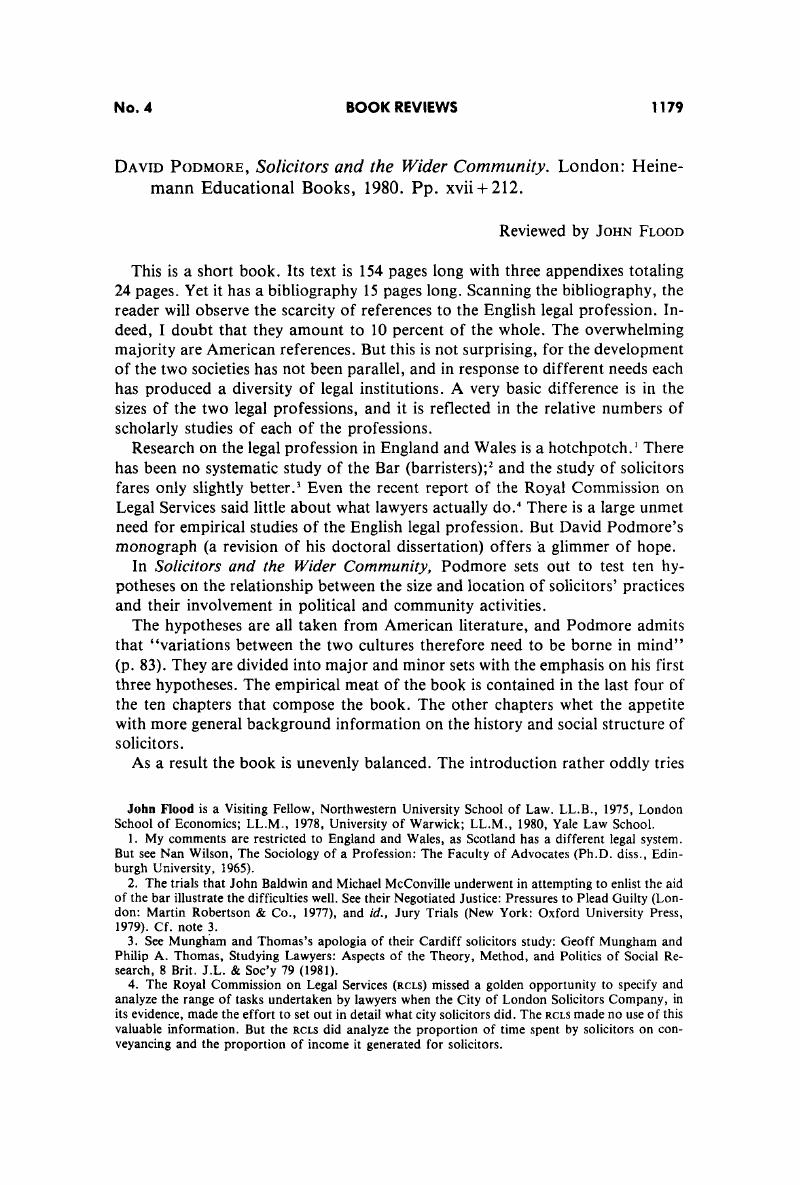No CrossRef data available.
Article contents
David Podmore, Solicitors and the Wider Community. London: Heinemann Educational Books, 1980. Pp. xvii + 212.
Published online by Cambridge University Press: 20 November 2018
Abstract

- Type
- Book Reviews
- Information
- Copyright
- Copyright © American Bar Foundation, 1981
References
1. My comments are restricted to England and Wales, as Scotland has a different legal system. But see Nan Wilson, The Sociology of a Profession: The Faculty of Advocates (Ph.D. diss., Edinburgh University, 1965).Google Scholar
2. The trials that John Baldwin and Michael McConville underwent in attempting to enlist the aid of the bar illustrate the difficulties well. See their Negotiated Justice: Pressures to Plead Guilty (London: Martin Robertson & Co., 1977), and id., Jury Trials (New York: Oxford University Press, 1979). Cf. note 3.Google Scholar
3. See Mungham and Thomas's apologia of their Cardiff solicitors study: Mungham, Geoff and Thomas, Philip A., Studying Lawyers: Aspects of the Theory, Method, and Politics of Social Research, 8 Brit. J.L. & Soc'y 79 (1981).Google Scholar
4. The Royal Commission on Legal Services (RCLS) missed a golden opportunity to specify and analyze the range of tasks undertaken by lawyers when the City of London Solicitors Company, in its evidence, made the effort to set out in detail what city solicitors did. The RCLS made no use of this valuable information. But the RCLS did analyze the proportion of time spent by solicitors on conveyancing and the proportion of income it generated for solicitors.Google Scholar
5. Campbell, C. M. & Wiles, Paul, The Study of Law in Society in Britain, 10 Law & Soc'y Rev. 547 (1976).Google Scholar
6. One example will suffice: Podmore uses Lee Bridges et al., Legal Services in Birmingham (Birmingham, Eng.: Institute of Judicial Administration, 1975). Their method breaks down solicitors' work by bills delivered. Heinz and Laumann suggested a more sophisticated and thorough method of analysis, defining fields of law according to a schema which required that to be counted as a specialist the lawyer must spend a minimum of 25 percent of his or her time on a particular field; to be counted active in the field, the respondent only needed to indicate spending 5 to 25 percent of time in a field. See Laumann, Edward O. & Heinz, John P., The Organization of Lawyers' Work: Size, Intensity, and Co-Practice of the Fields of Law, 1979 A.B.F. Res. J. 217.Google Scholar
7. Furthermore, in his comparative section Podmore excludes Roman Tomasic's work on the New South Wales bar. See, e.g., Lawyers and the Community (North Sydney, Austl.: Law Foundation of New South Wales; Hornsby, Austl.: George Allen & Unwin Australia Pty., 1978).Google Scholar
8. It should be noted that in England and Wales law is a first degree, and is required for practice at the Bar, but not for practice as a solicitor. In both cases after taking a degree, law or otherwise, a further period of professional instruction is required and is administered and examined by the bar and The Law Society. If no law degree is held, then the secondary stage is extended to take account of that hiatus.Google Scholar
9. See Bridges et al., supra note 6; Baldwin & McConville, supra note 2.Google Scholar
10. In comparison, Heinz and Laumann did not study the organizations to which lawyers belong, but they have examined lawyers' networks in great detail in their forthcoming book, Chicago Lawyers: The Professions of the Bar. Also see Heinz, John P. et al., Diversity, Representation, and Leadership in an Urban Bar: A First Report on a Survey of the Chicago Bar, 1976 A.B.F. Res. J. 717; and Powell, Michael, Anatomy of a Counter-Bar Association: The Chicago Council of Lawyers, 1979 A.B.F. Res. J. 501.Google Scholar
11. To test the hypotheses, Podmore developed a set of indicators (app. III, at 168). For community activities data were collected on number of clubs, organizations, and associations of which a solicitor was a member; number of clubs, etc., in which solicitor was on a committee; whether he was a member of a public board or committee; whether he attends a voluntary law clinic (i.e., gives occasional free legal advice at a local social welfare center, but why, since this is a direct extension of a lawyer's work, did Podmore include it in this list?); the extent to which he believed that participation in community activities had helped his legal career; the extent to which he regarded partners' extramural activities as a source of clients in the practice; and whether he mentioned “getting known and making contacts” as a factor making for successful practice. A general indicator of “involvement in community activities” was derived by combining responses to the first two items above. The second set of indicators concerned political activities. Each respondent was asked the extent of his interest in politics; whether he was a member of a political party; whether he was a committee member or an officer of a political party; whether he had been a candidate at a general or local election; had been a local councillor; had helped a candidate in a general or local election campaign; and the extent to which he believed that participation in politics had helped his legal career. A general indicator of involvement in political activities was derived by using a Guttman scaling technique with the data from those responses. The final set of indicators involved professional activities. Each was asked whether he was a member of the national Law Society; member of a local law society; member of other lawyers' associations and groups; committee member of Law Society; member of a local legal aid committee; and frequency of his attendance at national and local law society meetings. A general indicator of professional involvement was created by using a Guttman scaling technique with information from those responses.Google Scholar
12. Hazard, Geoffrey C. Jr., Reflections on Four Studies of the Legal Profession, 12 Soc. Problems (Summer Supp.: Law and Society) 46, 50 (1965).Google Scholar




